
media coverage
by Jeremy Hance on 23 April 2019
If you flew over the island of Borneo in 1950, you would see nearly unbroken, untouched forest from one end to the other. Of course, there would be villages and cities, roads and trails, but the vast majority of the landscape would be forest. Much your flight might get boring: mangroves on the coast, lowland rainforest across much of the interior, montane forest in the highlands. Some of those forests would be 140 million years old and inhabited by hundreds of thousands of creatures, the vast majority (think insects and fungi) still unknown to science today.
That Borneo no longer exists. Beginning in the 1960s, the island — the third largest in the world — experienced a frenzy of industrial logging unmatched in human history. First the Malaysian states, Sabah and Sarawak, began mass logging to feed the appetites of Americans, Europeans and Japanese for things like outdoor furniture and throwaway chopsticks. Next, in Kalimantan, the Indonesian chunk of Borneo, the dictator Suharto handed out swaths of forests as gifts to top military cronies. By 1985, humans had cut down more than a quarter of the island’s forest.
Around the same time, palm oil began to take off in Malaysia: by 1980 the country had planted a million hectares (2.5 million acres) of the lucrative oil crop. That number has now more than quintupled, around half of it in Sabah and Sarawak, often at the expense of Bornean forest. Indonesia soon followed Malaysia’s palm oil lead, with a boom that today covers a staggering 12 million hectares (30 million acres) — an area three times the size of Switzerland — most of it in Sumatra and Borneo.
Since 1950, Borneo has lost around half of its forest cover and only a quarter has never been logged. Today, flying over the island, you see a matrix of degraded forest, logging concessions, oil palm plantations, urban and suburban areas, and some primary forest.
Such destruction comes with consequences. A study from last year found that this orgy of deforestation has left the island hotter and drier, with stark consequences not only for Borneo’s remaining forests and wildlife, but also its people and its agricultural sector.
When the forest goes, so does the cool…
The study, published in Environmental Research Letters, found that deforested areas in Borneo experienced significantly higher temperatures than those with standing forest.
“Sit under a forest or in a big clearing on a sunny day and you will feel the difference. Forests are cool and clearings are hot,” says Douglas Sheil, co-author and a professor at the Norwegian University of Life Sciences. “Trees act as sun-shades protecting those beneath from the direct heat of the sun — like a parasol.”
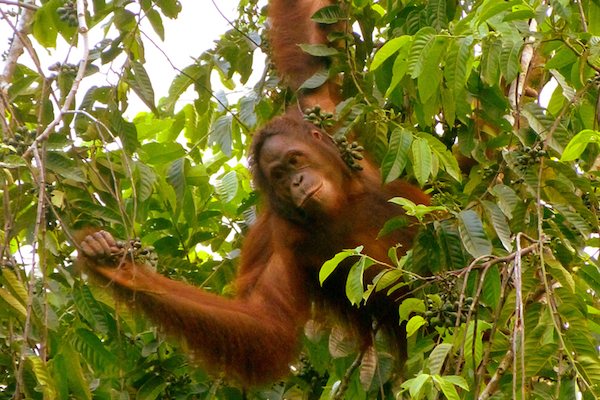
The Bornean Orangutan is listed as Critically Endangered by the IUCN Red List, largely due to habitat loss and conflict with humans working in industrialized agriculture. Photo by: Douglas Sheil.
Overall, the research found that deforested areas in the Bornean lowlands were 1.7 degrees Celsius (3 degrees Fahrenheit) warmer than forested areas. But it was even worse for oil palm plantations: they are 2.8 to 6.5 degrees Celsius (5 to 11.7 degrees Fahrenheit) warmer than primary forest.
The researchers also found that watersheds in southeast Borneo, which have lost 40 to 75 percent of their forest, experienced extreme temperatures above 31 degrees Celsius (87.8 degrees Fahrenheit) with greater frequency than other forested regions.
When Erik Meijaard, co-author and research scientist with Borneo Futures, interviewed 7,000 people in Borneo in 2008 about how deforestation was impacting their well-being, he found “The common answer was that deforestation makes their world so much hotter.”
Of course, such local temperature rises are already on top of a warming planet, which on average has heated up by 1 degree Celsius (1.8 degrees Fahrenheit) since the Industrial Revolution.
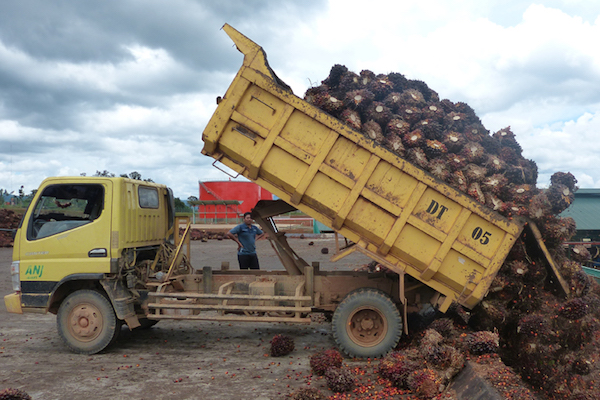
Palm oil fruits from Borneo. Much of recent deforestation is directly linked to this global commodity. Photo by: Douglas Sheil.
…And the rain
If sunshine reaches the ground, it generally heats things up. But what happens to the sunlight that hits an unbroken forest canopy? If it’s not turned into heat and it’s not reflected back into space, then it must be doing something else. And this is where clouds and rainfall comes in.
“Typically around half of all the energy from the sun that hits the Earth’s land goes into evaporating water rather than heating,” Sheil says. Forests are “effective structures” at turning the water stored in their vegetation and in the soil around their roots into water vapor by harnessing the sun’s energy, he says.
This process creates clouds, further fueled by special particles released by trees that help seed cloud cover (incidentally, coral reefs also seed clouds). Clouds not only provide shade, but also bounce sunshine directly back into space, cooling our planet.
And, of course, all this water vapor and clouds eventually lead to rain: where there are rainforests, there is rain.
But if the forests are gone, the water in the soils and vegetation is far more likely to be stripped off into local rivers and carried out to sea instead of being recycled as local rainfall.
The study found that while rainfall across Borneo was generally stable from 1951 to 1971 (at 6.7 millimeters, or 0.26 inches, a day) it began to fall off soon after. From 1973 to 2007, daily precipitation fell by 0.04 millimeters — every year. This second period had an average daily rainfall of 5.68 millimeters (0.22 inches). Overall, the study found that Borneo’s precipitation has fallen by around 20 percent in less than 60 years.
On average, Borneo’s annual rainfall is now some 880 millimeters (34.6 inches) less than it was in the 1950s, Meijaard says. “To put that into perspective, this is more than the total annual rainfall in pretty wet countries like the Netherlands.”
Feeling the heat
The study didn’t look at how this decline in rainfall and rise in local heat may be affecting the well-being of the people in Borneo, but Sheil says it’s undeniably having an impact.
“When I was in Borneo [in 2018] it was obvious how difficult it has become for farmers to produce crops in the severe heat and intermittent droughts that tend to occur in the region,” he says, noting that it appeared farmers planting out in the open suffered more than those who farmed under significant tree cover.
“If these climate trends continue I have little doubt that the wider impacts will become more severe.”
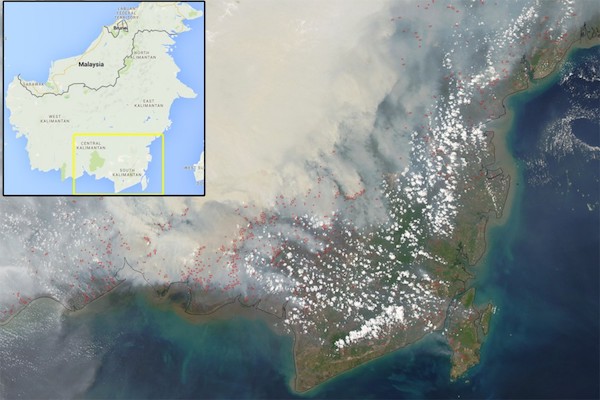
Smoke pouring from peat fires in southeast Borneo caught by Moderate Resolution Imaging Spectroradiometer (MODIS) on NASA’s Aqua satellite on October 19, 2015. Red outlines indicate hot spots where the sensor detected unusually warm surface temperatures associated with fires. ASA image Jeff Schmaltz (LANCE MODIS Rapid Response) and Adam Voiland (NASA Earth Observatory).
All this will also lead to a graver threat of fires, according to Sheil. In many parts of Indonesia, burning is still a typical way to clear land — though the government has tried to stop it — leading to what’s known annually as the Southeast Asian “haze.”
In 2015, this annual crisis escalated into a full-blown regional catastrophe: dry conditions and thousands of intentionally set fires — sometimes in slow-burning, nearly impossible-to-extinguish peatlands — led to a blanket of haze covering much of Southeast Asia, leading to school closures, widespread respiratory problems, and estimated economic losses of $37 billion to $45 billion. A study a year later estimated that the air pollution likely led to the premature deaths of 100,000 people, but the governments have disputed this finding.
The ecological cost was unquantifiable: 2.1 million hectares (5.2 million acres) burned, an area the size of New Jersey. Who knows how much wildlife perished in the conflagration?
And past fire begets future fire.
“Once a forest has burned or been cleared it is much more vulnerable to future fires,” Sheil says.
Palm oil suicide?
All this means that one of Indonesia and Malaysia’s most important, and controversial, exports may be undercutting its own viability. Today, around 30 percent of Indonesian’s palm oil is produced in Indonesian Kalimantan (the rest in Sumatra), while about half of Malaysia’s palm oil is produced in Sabah and Sarawak.
“Oil palm…is most productive if humidity is maintained year round. The conditions we are seeing tend to be drier and less consistent and that will reduce yields,” Sheil says.
A reduction in yields could spur calls for the further expansion of oil palm plantations, which may come at the expense of more forest, exasperating the problem.
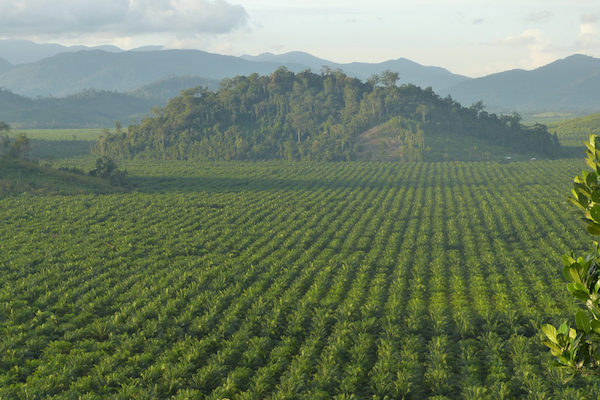
Palm oil plantations in Kalimantan (Indonesian Borneo) – the only forest left is on the hills. Photo by: Douglas Sheil.
Meijaard calls oil palm a “thirsty plant,” pointing to a recent study in Scientific Reports that showed oil palms needed around 167 millimeters (6.6 inches) of rain a month. It also showed that the plant doesn’t like temperatures above 29 to 33 degrees Celsius (84 to 91 degrees Fahrenheit).
“These conditions are now often exceeded, especially in the hotter and drier southeastern part of Borneo, and we may soon find that oil palm development there is no longer financially viable,” Meijaard says. “The race for water is on, which may also be one of the reasons that developers are keen to plant on peat, which stores a lot of water.”
But targeting peat for agriculture is poking a climate bear: disturbing these vast carbon sinks produces monstrous emissions of carbon dioxide — and may even create a feedback scenario where warm temperatures and drying degrade intact peatlands.
“Borneo could switch from a wet climate to a dry one,” Sheil says, warning that parts of the massive island may no longer be able to sustain rainforest.
Despite the disturbing findings and latent warnings in the study, Sheil says the work didn’t “get much publicity in the region” when it came out last year.
Meijaard concurs.
“I haven’t seen any mention of these issue in the local media,” he says. “Many politicians may not think much beyond the next several years towards their potential re-election, and this short-term thinking is not helpful in making the long-term land use changes required to ensure Borneo remains an environmentally healthy place.”
The study is also a warning shot across the bow for other rainforest regions.
“If Borneo is considered a microcosm for the effects of forest loss, I would expect the impacts to be markedly greater in the interior of the Congo and Amazon regions,” says Sheil, noting these rainforest’s greater distance from the oceans means they could see more rapid heating up and drying if forest loss goes on unchecked.
Rainforest means rain
Most of the arguments to save the world’s rainforests over the last decade in the mainstream media have been about one thing: carbon. Forests sequester vast amounts of carbon dioxide from the atmosphere, and destroying them releases it back into the atmosphere, stoking an already too-hot planet and pushing us even closer to a global catastrophe that’s difficult to wrap our minds around.
But while the argument to save forests for their role in mitigating climate change is hugely important, it has also come to overshadow the many other vital roles forests play in our world. The world’s rainforests house around 50 percent of the planet’s plant and animal species; they are home to hundreds of indigenous tribes, many of whose existence is threatened; they supply freshwater and mitigate erosion and harbor undiscovered pharmaceutical marvels, including those that could be the key to battling cancer. They also, as we have seen, maintain local weather and climates, providing rainfall and keeping the tropics cooler than they would otherwise be.
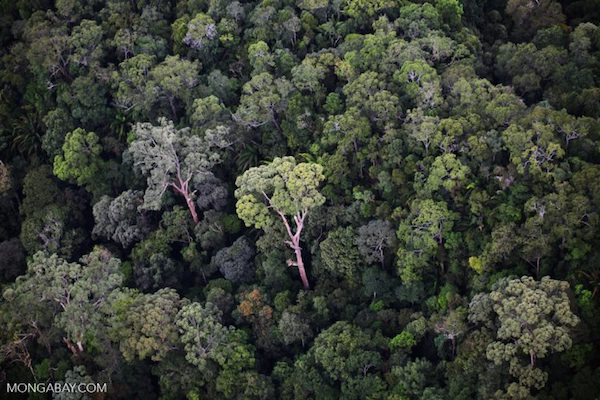
Emergent rainforest tree in Borneo.
And another reason may still come to light. A controversial theory, known as the “biotic pump,” theorizes that forests play a vital role in driving winds — and therefore “pumping” rainfall as well. Developed by two Russian scientists, Victor Gorshkov and Anastassia Makarieva, the theory, if verified, would revolutionize how we view the world’s forests. Yet for years the theory was anathema in meteorological circles, making it almost impossible to publish papers on the topic (a major paper on the biotic pump was finally published in 2013 — after more than two years of debate).
“There is still some hostility [to the biotic pump theory] but I think most people are also a little more careful to not dismiss the ideas entirely,” says Sheil, a co-author of that paper. He also says the idea has garnered more allies in recent years.
Science like this takes time work out, but it’s already clear that the destruction of rainforests in Borneo and elsewhere leads to a twin-headed climatological monster: decreased rainfall and rising temperatures. These forests don’t just store carbon: they maintain weather norms in an age of an unstable climate.